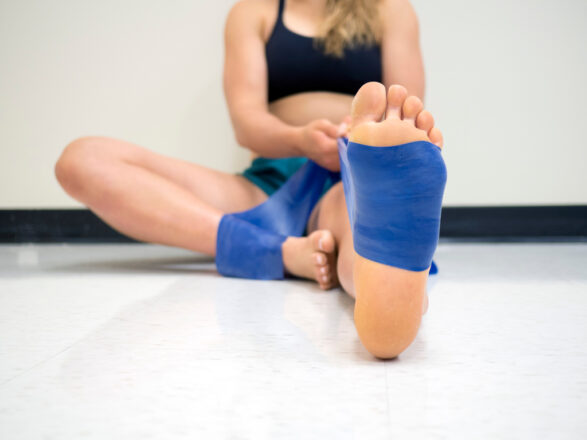If you’ve ever had an ankle sprain, you know just how important your ankle is for balance and easy movement. Strong ankles have good mobility. And as a runner, good ankle mobility is a big plus.
Ankle dorsiflexion happens when you draw your toes toward your shin. It’s a movement that’s easy to take for granted unless an injury affects your ankle mobility.
In this post, we answer, “What is ankle mobility?” and share with you the best exercises for ankle mobility.
Read on to find out more.
In This Article:
Causes of Poor Ankle Mobility
Poor ankle mobility has several causes, from genetics, age, and gender to overtraining. Let’s take a closer look at them.
- Genetics – A 2017 study associated certain alleles (forms of a gene) with a higher risk of ankle injury.
- Age and gender – Ankle mobility decreases as we age. Young males often have poorer ankle mobility than young females. By comparison, older females tend to have poorer ankle mobility than older males.
- Medical conditions – Osteoarthritis may cause the ankle joint to become stiff and painful. Typically affecting older people, it may also occur before age 45, when it’s more common among men. The inflammation of soft tissue around the ankle may also impair ankle mobility.
- Weak lower leg muscles – Research shows that the strength of muscles involved in ankle dorsiflexion (the backward bending of the foot) affects ankle mobility.
- Overtraining – Training too hard too soon can lead to ankle and lower leg injuries impairing ankle flexion and mobility. This can include running too much. Common injuries affecting ankle dorsiflexion include ankle sprains, fractures, and ruptured or torn tendons or ligaments.
- Postural adaptations and adaptive changes – Playing sports that require lots of running and jumping or wearing high heels all the time may also limit ankle mobility. This happens because of adaptive changes to the anterior talofibular ligament. This ligament is attached to the large bone of the ankle and the fibula.
Why Limited Ankle Mobility Can Be a Problem
For many runners and gym-goers, improving ankle mobility isn’t a priority. However, limited ankle mobility can have far-reaching effects beyond ease of movement. Here are some of the key reasons why good ankle flexibility is important.
- Affects everyday activities – From putting on shoes and climbing stairs to driving a car, good ankle mobility makes many everyday activities easier.
- Makes it harder to stay active – Your body relies on your ankles for support. Poor ankle mobility can make running, working out, or playing sports harders. It impairs many functional movement patterns, including landing from a jump and squatting.
- Impairs performance – Poor ankle mobility can reduce your performance while playing sports and possibly while running.
- Higher risk of ankle injury – Limited ankle mobility can be a sign of a weak ankle that is more susceptible to sprains and other injuries. A 2014 study found that runners who strengthened their ankles may reduce their risk of injury.
- Leg pain – Poor ankle dorsiflexion can contribute to knee and lower leg pain.
What Is the Normal Range of Motion for Ankle Dorsiflexion?
The normal range of motion for ankle dorsiflexion is between 10 and 20 degrees. However, judging from studies on the subject, there’s a lot of individual variation.
By comparison, the average plantar flexion range of motion is 40 to 55 degrees. Plantar flexion happens when you stand on tiptoes.
Using these values as reference points, you can test your ankle mobility. This is useful before we look at how to improve ankle mobility.
It gives you an idea of how good your base ankle mobility is. It also enables you to spot differences between the ankles.
One ankle can have better mobility than the other. Knowing this can help you correct the deficit with the right exercises for ankle mobility.
Ankle Mobility Test
A simple and effective ankle mobility test you can do at home is the knee-to-wall test. It’s quick and easy. Follow the steps below.
1. Place a ruler next to a wall.
2. Remove your shoes.
3. Place one foot around 5 inches from the wall.
4. Place the other foot behind it at another foot’s distance.
5. Bend your front knee so that the knee touches the wall and your heel remains on the ground. As you perform this movement, lift your other foot off the ground on your toes.
6. Make sure that your front knee remains over your toes. Your foot shouldn’t roll inwards.
7. If you cannot touch the wall with your knee without lifting your heel, shift your front foot forward and repeat until you can. Record the distance.
8. Repeat the test with the other leg and record the distance for it too.
The results: Unable to touch the wall with your knee? It’s a sign of poor ankle mobility. Also, note any differences between the feet.
Strength Exercises to Improve Ankle Mobility (Dorsiflexion)
You can choose from a variety of ankle mobility exercises. Start with lighter ones and try to incorporate them into your weekly workouts. Do ankle mobility exercises 3 times a week or according to your training plan.
Heel raises
Heel raises are one of the best ankle mobility exercises for beginners.
- Rest your hands on a table, the back of a chair, a wall, or another support.
- Stand with feet about 4 inches apart.
- Raise your heels off the floor with a slow, controlled movement while keeping your knees straight.
- Maintain the position for about 5–6 seconds.
- Lower your heels slowly to the floor.
- Repeat 10–12 times for up to 3 sets with a short rest in between sets.
Toe raises/heel drops
These can feel a bit more challenging than heel raises but are very effective.
- Stand on a step with the front part of your feet and your heels unsupported. Your feet should be about 4 inches apart.
- Raise your feet slowly on tiptoes and hold the position at the top for a second.
- Lower your heels slowly to below the step level with a controlled movement.
- Repeat 10–12 times for up to 3 sets.
Ankle flexion (dorsiflexion)
For this exercise, you’ll need a stretch band. Secure one end of the band around a chair leg before you begin.
- Sit on the floor before the chair and stretch out your legs.
- Wrap the free end of the stretch band around your foot.
- Point your toes toward you with a slow ankle movement.
- Return your foot to the initial position.
- Complete 10 reps and then switch to the other foot.
- Do 3 sets for each foot.
Toe-heel walks
These are some of the best ankle stability exercises you can do.
- Use a pair of shoes with a flat sole. Or do this exercise barefooted on a soft surface.
- Stand on your toes and walk about 30 feet.
- Then walk on your heels for the same distance. If you’re doing this exercise in a room, you can walk in circles for the equivalent distance.
- Repeat both up to 5 times.
Lunges
Static lunges are a simple way to work your ankle mobility.
- Place one foot in front of the other.
- Bend your back knee until it almost touches the floor while you keep your back straight.
- Push yourself up and repeat 10 times for each leg.
- Do 2 sets for each leg.
Walking lunge
Once you’re comfortable with static lunges, you can move on to walking lunges.
- Take a step forward with one leg, bending the front knee at a right angle while lowering your back knee to the ground.
- Maintain the position for 3–5 seconds.
- Step forward with your back leg and repeat the movement.
- Do 10 lunges per leg.
Ankle jumps
Now here’s a more challenging exercise.
- Stand with hands on hips and feet apart.
- Jump up with your knees straight and pull your toes toward you in the air, flexing your ankles toward you.
- Extend the ankles back before landing.
- Jump again, pushing the balls of your feet into the floor with an explosive movement.
- Repeat while aiming to keep your feet on the floor for as little time as possible for 10–20 repetitions.
- Do 3 sets.
Double leg hops
You’re looking at one of the simplest ankle mobility exercises.
- Stand with feet apart, back straight, and arms at your sides.
- Jump up, raising your arms.
- Do 10 reps.
Single leg hops
For an extra challenge, do the hopping on one foot.
- Stand with arms at your sides and back straight.
- Jump up on one leg, raising your arms.
- Do 10 reps.
Overhead squat
For this exercise, you need a barbell. If you’re new to it, don’t add any plate weights. You can add them later to up the challenge.
- Stand with feet at shoulder width.
- Rest the barbell across the back of your shoulders while keeping your hands wide on it.
- Engage your core, bend your knees, and drop your hips, keeping your torso upright all the while.
- Extend your knees and hips as you lift the barbell over your head, fully extending your elbows.
- Bend your wrists back slightly. The barbell should be over the center of your feet.
- Next, bend your knees and squat down, maintaining your core engaged and chest up. Squat as low as you feel comfortable. Keep your knees and toes aligned.
- Return to the starting position with a steady movement. Press through your feet and use your leg muscles and core to extend your knees.
- Do 5 reps.
Improving Ankle Mobility After Injury
Over 2 million ankle injuries occur every year in the US. These include ankle sprains, strains, and fractures.
After an ankle injury, up to 70% of patients have chronic ankle instability. This is a chronic or recurring pain outside the ankle.
Ankle sprains are among the most common ankle injuries, and they often affect runners. A simple misstep can cause an ankle sprain.
Ankle sprains occur when the ligaments supporting the ankle overstretch and tear. They range in intensity from minimal stretching to full rupture.
To reduce pain and swelling, follow the RICE method:
1. Rest.
2. Ice the area for up to 20 minutes.
3. Compress the ankle with an elastic ankle sleeve.
4. Elevate your ankle when seated.
Important: If symptoms don’t lessen after 24–48 hours, see a doctor.
Rather than having to treat ankle strains, it’s better to prevent them in the first place. Proprioceptive training can help prevent ankle sprains, according to this study.
Priopercetion is your body’s ability to sense movement, action, and location. Without it, you wouldn’t be able to run without looking at your feet.
Training it boosts your physical fitness. It does this by improving stability, posture, balance, and coordination.
Prioperception training to prevent ankle strains includes balancing on one leg with eyes closed.
Important: Working with a personal trainer is the best way to choose the optimal exercises to recover ankle mobility after a sprain or another injury.
Takeaways
Before you start doing ankle mobility stretches and other exercises, here are a few things to remember:
- Test your ankle mobility before you do any ankle mobility exercises.
- Don’t strain your ankles with tough exercises. Start with easy ankle stretches and exercises like the ones we shared.
- Preventing ankle injuries is better than having to treat them. Ankle mobility exercises help strengthen your ankles to prevent injury.
- Good ankle mobility can make you a better runner and reduce injury risk.
- Build ankle stretches and other exercises into your weekly workouts.
In the end, remember that strong ankles make strong runners. Don’t take your ankles for granted. Work them out every week!














